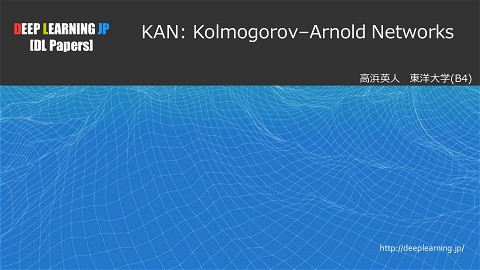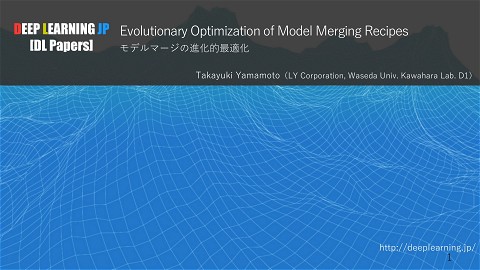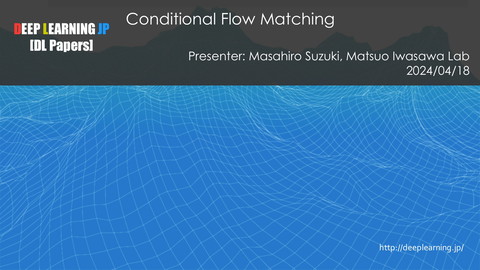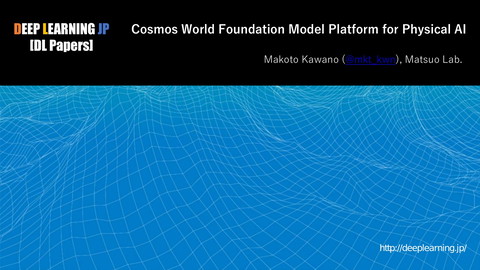[DL輪読会]EfficientDet: Scalable and Efficient Object Detection
431 Views
November 22, 19
スライド概要
2019/11/22
Deep Learning JP:
http://deeplearning.jp/seminar-2/
DL輪読会資料
関連スライド
各ページのテキスト
DEEP LEARNING JP [DL Seminar] EfficientDet: Scalable and Efficient Object Detection Hiromi Nakagawa ACES, Inc. https://deeplearning.jp
Overview • Mingxing Tan, Ruoming Pang, Quoc V. Le(Google Research, Brain Team) – EfficientNet の著者チーム – • Submitted to arXiv on 2019/11/20 物体検出でEfficientNetする – Weighted Bi-directional Feature Pyramid Network (BiFPN): マルチスケールの特徴を効率的に抽出 – Compound Scaling: resolution, depth, widthを一つの変数でスケール • COCOで精度/サイズ/速度などでSoTAを更新 – #Params: 4x smaller – FLOPs: 9.3x fewer 2
Introduction
Introduction • 近年のObject Detectionのモデルは巨大化しがち – AmoebaNet-based NAS-FPN:167M parameters, 3045B FLOPs(30x more than RetinaNet) – ロボティクスや自動運転といったReal-worldへのdeployの妨げに – モデルをEfficientにすることの重要性が高まっている • 軽量化の傾向もあるが、精度が犠牲になっている – One-stage, Anchor-free, Compression • 特定のリソースに最適化するだけでもダメ。いろんなリソース制約に対応できるモデルがほしい – 3B FLOPs ~ 300B FLOPs ? 4
Introduction • 高精度と高効率を両立することはできるか?Detectorの設計について体系的に調査 • Challenge 1: Efficient Multi-Scale Feature Fusion – マルチスケールの特徴を簡潔かつ効果的に抽出する Bidirectional Feature Pyramid Network (BiFPN) を提案 • Challenge 2: Model Scaling – 入力画像の解像度に加えてネットワークの幅や深さなどをまとめてスケーリングするCompound Scalingを提案 • そもそも強いEfficientNetもBackboneに使う 5
Proposed Method
BiFPN: Bi-directional Feature Pyramid Network • 𝑖𝑛 Multi-scale fusion => aggregate features at different resolutions:𝑃 𝑖𝑛 = (𝑃𝑙𝑖𝑛 , … , 𝑃 ) 𝑙 1 𝑛 ex. Faster-RCNN, YOLO 上層の解像度が低くなる ex. SSD 下層の特徴抽出が不十分 下層も大域特徴(コンテキスト)を 利用でき、解像度も高い [Lin+ CVPR’17] Feature Pyramid Networks Ref. https://www.slideshare.net/ren4yu/single-shot 7
BiFPN: Bi-directional Feature Pyramid Network • (a) Conventional top-down FPN – Limited by the one-way information flow 8
BiFPN: Bi-directional Feature Pyramid Network • (b) PANet – Adds extra bottom-up path aggregation network • (c) NAS-FPN – Neural architecture search – Requires thousands of GPU hours for search – Irregular network, difficult to interpret or modify 9
BiFPN: Bi-directional Feature Pyramid Network • (e) Simplified PANet – PANet: Accurate but needs more parameters and computations • (f) BiFPN – Extra edges from input to output at the same level – Repeat feature network layer (=bidirectional path) – Remove the nodes whit only 1 input edge 10
BiFPN: Bi-directional Feature Pyramid Network • Weighted feature fusion:How to fuse multi-scale features? – Equally sum? → x – Introduce additional weights, let the network to learn the importance of each input feature – Unbound fusion: • 𝑤𝑖 :scalar(per-feature), vector(per-channel), tensor(per-pixel) • scalar is enough but needs bounding for stable training – Soft-max fusion: • Slowdown on GPU – Fast normalized fusion: • Efficient 11
EfficientDet Architecture • Backbone: ImageNet pretrained EfficientNet • Repeat BiFPN Layer • Class & Box prediction networks share weights across all level of features 12
Compound Scaling • Use compound coefficient 𝝓 to jointly scale up all dimensions – Object detection model has much more scaling dimensions than image classification models Backbone Network 𝐵0, … , 𝐵6 #channels #layers 𝑊𝑏𝑖𝑓𝑝𝑛 = 64 ∙ (1.35𝜙 ) 𝐷𝑐𝑙𝑎𝑠𝑠 = 3 + 𝜙/3 #layers Input size 𝑅𝑖𝑛𝑝𝑢𝑡 = 512 + 𝜙 ∙ 128 𝐷𝑏𝑖𝑓𝑝𝑛 = 2 + 𝜙 13
Experiments
Experiments • Trained with batch size 128 on 32 TPUv3 chips • COCO2017で精度/パラメータ数/速度などでSoTAを達成 15
Experiments • Trained with batch size 128 on 32 TPUv3 chips • COCO2017で精度/パラメータ数/速度などでSoTAを達成 16
Experiments • Real-world latency:Run 10 times with batch size 1 • GPU( Titan-V ): Up to 3.2x faster • CPU( Single-thread Xeon ):Up to 8.1x faster 17
Experiments • Ablation Study ✓ EfficientNet BackboneにするだけでもRetinaNetから改善 ✓ FPNをBiFPNにすると更に改善 ✓ BiFPNは他のfeature networksに比べて 高精度かつ少パラメータ/低FLOPs 18
Experiments • Ablation Study ✓ Feature fusionをSoftmaxからFast Fusionにすると ほとんど精度低下せずに30%ほど高速化できる Softmax Fusion ✓ Compound Scalingによって個別にスケールを最適化 するより優れたmAP/FLOPsのモデルが得られる Fast Fusion 19
Conclusion
まとめ • 高速・高精度・省計算な物体検出モデルであるEfficientDetを提案 – EfficientNetをBackboneに – マルチスケールの特徴を効率的に抽出するBiFPNモジュールを提案、複数積み重ねて高次の特徴も抽出 – 共通の変数で解像度/幅/深さを複合的にスケーリングするCompound Scalingによる効率的なパラメータ探索 • COCOデータでSoTAの精度/速度を達成 – 4x smaller and 9.3x fewer FLOPs – Latency:3.2x faster @GPU、8.1x faster@CPU 21
感想 • シンプルな工夫/拡張で精度/速度を改善。そりゃ良くなるよな、という感じ – NAS-FPNみたいな魔改造感がない • YOLOv3(arXiv18.04)の某グラフと比べると進展の速さを感じる • その他 – Efficientだし精度もSoTAを更新した。 より精度を上げるためにEfficientさを捨てるとしたらどの方向? – 最小解像度が512からの比較。それより小さくなると? – 他の評価指標(mAPxx)やデータセットでのパフォーマンスは? – Compound Scalingにおけるヒューリスティック、どれくらいセンシティブ? – Keypointベースのアプローチと組み合わせるとどんな感じになる? ここらへん? 22







